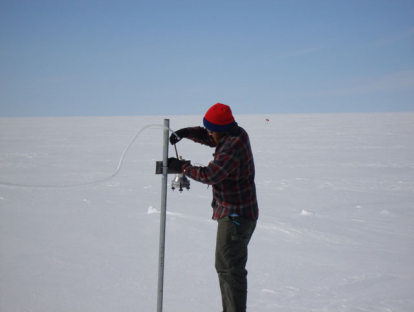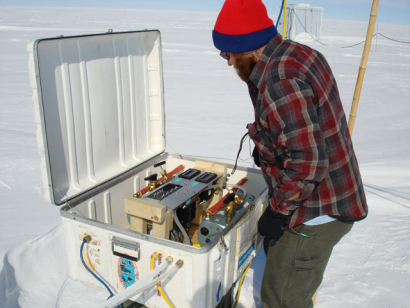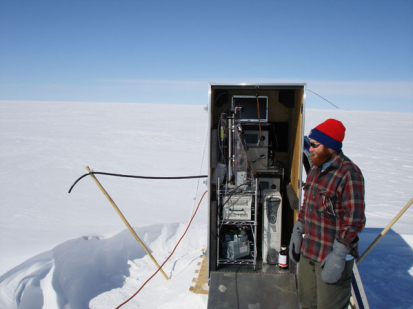Luke Ziemba graduated with BS in chemistry, working with organic compounds in soil and water. Now, at UNH he measures aerosols in the atmosphere. AerosolsTiny solid particles or liquid droplets that remain suspended in the atmosphere for a long time. Aerosols are produced by natural processes or human activities, such as volcanic dust, sea spray, smoke from forest fires, particles emitted during the burning of fossil fuels, etc. are liquids or solids suspended in gas. Some aerosols can scatter light and produce a cooling effect (white house effect). Other aerosols can absorb light, such as black carbon.
Luke attaching the filter

At UNH, Luke uses the AMS (aerosol mass spectrometer) to analyze ambient aerosol samples. He likes using this instrument because it gives both physical particle size as well as chemical composition of the particles. But here at Summit, his experiment is looking for total organic carbon and total elemental black carbon. He uses filters to sample air for 48 hours. The flow meter keeps 60 Liters/minute flowing past the filter. There is a control on the pump which will shut it off if the winds are from the North (direction of the main camp). These North winds would skew the data. The quartz filters are brought back to the lab. He will use a ‘punch’ of the filter, 1.5 cm2, and heat it up to extract the organic compounds and convert them to carbon dioxide gas. He will also use another ‘punch’ in water to extract and measure total carbon which is soluble in water.
Luke adjusting pump and flow meter

Here at Summit, Luke wants to find out if aerosols are being made in the atmosphere from compound emitted from the snow. The total aerosol count is extremely low here at Summit, Greenland, 300 particles/cm3, whereas by comparison rural New Hampshire is about 6000 particles/cm3 and Houston is 10,000 particles/cm3 (closer to source of particles). The aerosols can have implications for health and climate.
Scanning Mobility Particle Sizer



Comments